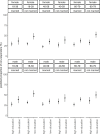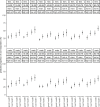Non-response in a national health survey in Germany: An intersectionality-informed multilevel analysis of individual heterogeneity and discriminatory accuracy
- PMID: 32776957
- PMCID: PMC7416954
- DOI: 10.1371/journal.pone.0237349
Non-response in a national health survey in Germany: An intersectionality-informed multilevel analysis of individual heterogeneity and discriminatory accuracy
Abstract
Background: Dimensions of social location such as socioeconomic position or sex/gender are often associated with low response rates in epidemiological studies. We applied an intersectionality-informed approach to analyze non-response among population strata defined by combinations of multiple dimensions of social location and subjective health in a health survey in Germany.
Methods: We used data from the cross-sectional sample of the German Health Interview and Examination Survey for Adults (DEGS1) conducted between 2008 and 2011. Information about non-responders was available from a mailed non-responder questionnaire. Intersectional strata were constructed by combining all categories of age, sex/gender, marital status, and level of education in scenario 1. Subjective health was additionally used to construct intersectional strata in scenario 2. We applied multilevel analysis of individual heterogeneity and discriminatory accuracy (MAIHDA) to calculate measures of discriminatory accuracy, proportions of non-responders among intersectional strata, as well as stratum-specific total interaction effects (intersectional effects). Markov chain Monte Carlo methods were used to estimate multilevel logistic regression models.
Results: Data was available for 6,534 individuals of whom 36% were non-responders. In scenario 2, we found weak discriminatory accuracy (variance partition coefficient = 3.6%) of intersectional strata, while predicted proportions of non-response ranged from 20.6% (95% credible interval (CI) 17.0%-24.9%) to 57.5% (95% CI 48.8%-66.5%) among intersectional strata. No evidence for intersectional effects was found. These results did not differ substantially between scenarios 1 and 2.
Conclusions: MAIHDA revealed that proportions of non-response varied widely between intersectional strata. However, poor discriminatory accuracy of intersectional strata and no evidence for intersectional effects indicate that there is no justification to exclusively target specific intersectional strata in order to increase response, but that a combination of targeted and population-based measures might be appropriate to achieve more equal representation.
Conflict of interest statement
The authors have declared that no competing interests exist.
Figures





Similar articles
-
Intersectional analysis of social disparities in type 2 diabetes risk among adults in Germany: results from a nationwide population-based survey.BMC Public Health. 2024 Feb 16;24(1):498. doi: 10.1186/s12889-024-17903-5. BMC Public Health. 2024. PMID: 38365644 Free PMC article.
-
Socioeconomic differences in body mass index in Spain: An intersectional multilevel analysis of individual heterogeneity and discriminatory accuracy.PLoS One. 2018 Dec 10;13(12):e0208624. doi: 10.1371/journal.pone.0208624. eCollection 2018. PLoS One. 2018. PMID: 30532244 Free PMC article.
-
Chronic Obstructive Pulmonary Disease in Sweden: An intersectional multilevel analysis of individual heterogeneity and discriminatory accuracy.SSM Popul Health. 2018 Mar 20;4:334-346. doi: 10.1016/j.ssmph.2018.03.005. eCollection 2018 Apr. SSM Popul Health. 2018. PMID: 29854918 Free PMC article.
-
Practice of reporting social characteristics when describing representativeness of epidemiological cohort studies - A rationale for an intersectional perspective.SSM Popul Health. 2020 Jun 20;11:100617. doi: 10.1016/j.ssmph.2020.100617. eCollection 2020 Aug. SSM Popul Health. 2020. PMID: 32685654 Free PMC article. Review.
-
Measurement of gender as a social determinant of health in epidemiology-A scoping review.PLoS One. 2021 Nov 3;16(11):e0259223. doi: 10.1371/journal.pone.0259223. eCollection 2021. PLoS One. 2021. PMID: 34731177 Free PMC article.
Cited by
-
Health inequalities at the intersection of multiple social determinants among under five children residing Nairobi urban slums: An application of multilevel analysis of individual heterogeneity and discriminatory accuracy (MAIHDA).PLOS Glob Public Health. 2024 Feb 29;4(2):e0002931. doi: 10.1371/journal.pgph.0002931. eCollection 2024. PLOS Glob Public Health. 2024. PMID: 38422055 Free PMC article.
-
The effects of social determinants on children's health outcomes in Bangladesh slums through an intersectionality lens: An application of multilevel analysis of individual heterogeneity and discriminatory accuracy (MAIHDA).PLOS Glob Public Health. 2023 Mar 8;3(3):e0001588. doi: 10.1371/journal.pgph.0001588. eCollection 2023. PLOS Glob Public Health. 2023. PMID: 36963045 Free PMC article.
-
Intersectionality-Informed Sex/Gender-Sensitivity in Public Health Monitoring and Reporting (PHMR): A Case Study Assessing Stratification on an "Intersectional Gender-Score".Int J Environ Res Public Health. 2023 Jan 26;20(3):2220. doi: 10.3390/ijerph20032220. Int J Environ Res Public Health. 2023. PMID: 36767592 Free PMC article.
-
Trend of estimated participation rate by regional block, gender, and age group in the 1997-2019: National Health and Nutrition Survey in Japan.PLoS One. 2024 Mar 13;19(3):e0286169. doi: 10.1371/journal.pone.0286169. eCollection 2024. PLoS One. 2024. PMID: 38478512 Free PMC article.
-
CART-analysis embedded in social theory: A case study comparing quantitative data analysis strategies for intersectionality-based public health monitoring within and beyond the binaries.SSM Popul Health. 2020 Dec 17;13:100722. doi: 10.1016/j.ssmph.2020.100722. eCollection 2021 Mar. SSM Popul Health. 2020. PMID: 33385059 Free PMC article.
References
-
- Porta M. A dictionary of epidemiology. New York, NY: Oxford university press, p. 247; 2014.
-
- International Committee of Medical Journal Editors. Recommendations for the Conduct, Reporting, Editing and Publication of Scholarly Work in Medical Journals. 2018. [accessed 03.06.2019]. Available from: http://www.ICMJE.org, accessed 03.06.2019. - PubMed
-
- Anthias F. Hierarchies of social location, class and intersectionality: Towards a translocational frame. Int Sociol. 2012;28(1):121–38.
Publication types
MeSH terms
LinkOut - more resources
Full Text Sources

